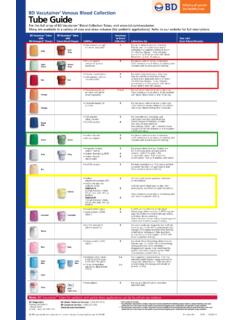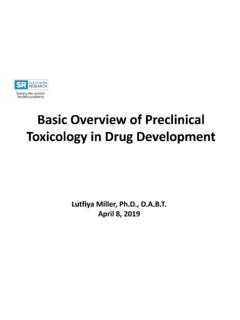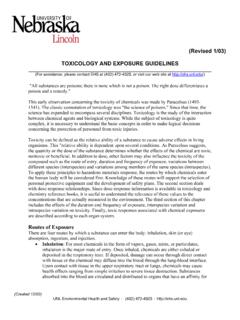Transcription of S 3 A Toxicokinetics: A Guidance for Assessing Systemic ...
1 European Medicines Agency 7 Westferry Circus, Canary Wharf, London, E14 4HB, UK Tel. (44-20) 74 18 85 75 Fax (44-20) 75 23 70 40 E-mail: EMEA 2006 Reproduction and/or distribution of this document is authorised for non commercial purposes only provided the EMEA is acknowledged June 1995 CPMP/ICH/384/95 ICH Topic S 3 A Toxicokinetics: A Guidance for Assessing Systemic Exposure in toxicology Studies Step 5 NOTE FOR Guidance ON TOXICOKINETICS: A Guidance FOR Assessing Systemic EXPOSURE IN toxicology STUDIES (CPMP/ICH/384/95) APPROVAL BY CPMP November 1994 DATE FOR COMING INTO OPERATION June 1995 EMEA 2006 2 NOTE FOR Guidance ON TOXICOKINETICS: A Guidance FOR Assessing Systemic EXPOSURE IN toxicology STUDIES ICH Harmonised Tripartite Guideline 1. INTRODUCTION 2. THE OBJECTIVES OF TOXICOKINETICS AND THE PARAMETERS WHICH MAY BE DETERMINED 3. GENERAL PRINCIPLES TO BE CONSIDERED Introduction Quantification of exposure Justification of time points for sampling Contribution to the setting of dose levels in order to produce adequate exposure Extent of exposure assessment in toxicity studies Complicating factors in exposure interpretation Route of administration Determination of metabolites Statistical evaluation of data Analytical methods Reporting 4.
2 TOXICOKINETICS IN THE VARIOUS AREAS OF TOXICITY TESTING - SPECIFIC ASPECTS Introduction Single-dose toxicity studies Repeated-dose toxicity studies Genotoxicity studies Carcinogenicity (oncogenicity) studies Reproductive toxicity studies 5. SUPPLEMENTARY NOTES 6. REFERENCES (OTHER ICH Guidance ) EMEA 2006 3 1. INTRODUCTION This Note for Guidance concerns toxicokinetics only with respect to the development of pharmaceutical products intended for use in human subjects. In this context, toxicokinetics is defined as the generation of pharmacokinetic data, either as an integral component in the conduct of non-clinical toxicity studies or in specially designed supportive studies, in order to assess Systemic exposure. These data may be used in the interpretation of toxicology findings and their relevance to clinical safety issues (see Note 1 for definitions of other terms used in this document).
3 The Note for Guidance has been developed in order to provide an understanding of the meaning and application of toxicokinetics and to provide Guidance on developing test strategies in toxicokinetics. The Guidance highlights the need to integrate pharmacokinetics into toxicity testing, which should aid in the interpretation of the toxicology findings and promote rational study design development. Toxicokinetic measurements are normally integrated within the toxicity studies and as such are described in this document as 'concomitant toxicokinetics' (Note 1). Alternatively, data may be generated in other supportive studies conducted by mimicking the conditions of the toxicity studies. Toxicokinetic procedures may provide a means of obtaining multiple dose pharmacokinetic data in the test species, if appropriate parameters are monitored, thus avoiding duplication of such studies; optimum design in gathering the data will reduce the number of animals required.
4 Various components of the total non-clinical pharmacokinetics and metabolism programme may be of value in contributing to the interpretation of toxicology findings. However, the toxicokinetic data focus on the kinetics of a new therapeutic agent under the conditions of the toxicity studies themselves. Toxicokinetics is thus an integral part of the non-clinical testing programme; it should enhance the value of the toxicological data generated, both in terms of understanding the toxicity tests and in comparison with clinical data as part of the assessment of risk and safety in humans. Due to its integration into toxicity testing and its bridging character between non-clinical and clinical studies, the focus is primarily on the interpretation of toxicity tests and not on characterising the basic pharmacokinetic parameters of the substance studied. As the development of a pharmaceutical product is a dynamic process which involves continuous feed-back between non-clinical and clinical studies, no rigid detailed procedures for the application of toxicokinetics are recommended.
5 It may not be necessary for toxicokinetic data to be collected in all studies and scientific judgement should dictate when such data may be useful. The need for toxicokinetic data and the extent of exposure assessment in individual toxicity studies should be based on a flexible step-by-step approach and a case-by-case decision making process to provide sufficient information for a risk and safety assessment. EMEA 2006 4 2. THE OBJECTIVES OF TOXICOKINETICS AND THE PARAMETERS WHICH MAY BE DETERMINED The primary objective of toxicokinetics is: to describe the Systemic exposure achieved in animals and its relationship to dose level and the time course of the toxicity study. Secondary objectives are: to relate the exposure achieved in toxicity studies to toxicological findings and contribute to the assessment of the relevance of these findings to clinical safety. to support (Note 1) the choice of species and treatment regimen in non-clinical toxicity studies.
6 To provide information which, in conjunction with the toxicity findings, contributes to the design of subsequent non-clinical toxicity studies. These objectives may be achieved by the derivation of one or more pharmacokinetic parameters (Note 2) from measurements made at appropriate time points during the course of the individual studies. These measurements usually consist of plasma (or whole blood or serum) concentrations for the parent compound and/or metabolite(s) and should be selected on a case-by-case basis. Plasma (or whole blood or serum) AUC, Cmax and C(time) (Note 2) are the most commonly used parameters in Assessing exposure in toxicokinetics studies. For some compounds it will be more appropriate to calculate exposure based on the (plasma protein) unbound concentration. These data may be obtained from all animals on a toxicity study, in representative subgroups, in satellite groups (see and Note 1) or in separate studies.
7 Toxicity studies which may be usefully supported by toxicokinetic information include single and repeated-dose toxicity studies, reproductive, genotoxicity and carcinogenicity studies. Toxicokinetic information may also be of value in Assessing the implications of a proposed change in the clinical route of administration. 3. GENERAL PRINCIPLES TO BE CONSIDERED Introduction In the following paragraphs some general principles are set out which should be taken into consideration in the design of individual studies. It should be noted that for those toxicity studies whose performance is subject to Good Laboratory Practice (GLP) the concomitant toxicokinetics must also conform to GLP. Toxicokinetic studies retrospectively designed to generate specific sets of data under conditions which closely mimic those of the toxicity studies should also conform to GLP when they are necessary for the evaluation of safety.
8 Quantification of exposure The quantification of Systemic exposure provides an assessment of the burden on the test species and assists in the interpretation of similarities and differences in toxicity across species, dose groups and sexes. The exposure might be represented by plasma (serum or blood ) concentrations or the AUCs of parent compound and/or metabolite(s). In some circumstances, studies may be designed to investigate tissue concentrations. When designing the toxicity studies, the exposure and dose-dependence in humans at therapeutic dose levels (either expected or established), should be considered in order to achieve relevant exposure at various dose levels in the animal toxicity studies. The possibility that there may be species EMEA 2006 5 differences in the pharmacodynamics of the substance (either qualitative or quantitative) should also be taken into consideration.
9 Pharmacodynamic effects or toxicity might also give supporting evidence of exposure or even replace pharmacokinetic parameters in some circumstances. Toxicokinetic monitoring or profiling of toxicity studies should establish what level of exposure has been achieved during the course of the study and may also serve to alert the toxicologist to non-linear, dose-related changes in exposure (Note 3) which may have occurred. Toxicokinetic information may allow better interspecies comparisons than simple dose/body weight (or surface area) comparisons. Justification of time points for sampling The time points for collecting body fluids in concomitant toxicokinetic studies should be as frequent as is necessary, but not so frequent as to interfere with the normal conduct of the study or to cause undue physiological stress to the animals (Note 4). In each study, the number of time points should be justified on the basis that they are adequate to estimate exposure (see ).
10 The justification should be based on kinetic data gathered from earlier toxicity studies, from pilot or dose range-finding studies, from separate studies in the same animal model or in other models allowing reliable extrapolation. Contribution to the setting of dose levels in order to produce adequate exposure The setting of dose levels in toxicity studies is largely governed by the toxicology findings and the pharmacodynamic responses of the test species. However, the following toxicokinetic principles may contribute to the setting of the dose levels. Low dose levels At the low dose, preferably a no-toxic-effect dose level (Note 5), the exposure in the animals of any toxicity study should ideally equal or just exceed the maximum expected (or known to be attained) in patients. It is recognised that this ideal is not always achievable and that low doses will often need to be determined by considerations of toxicology ; nevertheless, Systemic exposure should be determined.















